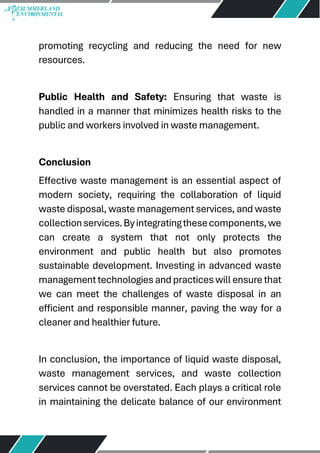Fascination About Reclaim Waste
Fascination About Reclaim Waste
Blog Article
Reclaim Waste Fundamentals Explained
Table of ContentsAll About Reclaim WasteThe 9-Minute Rule for Reclaim WasteWhat Does Reclaim Waste Mean?The Main Principles Of Reclaim Waste The Buzz on Reclaim Waste
Explore the types, events, and forms of liquid waste. Domestic sewage waste describes the waste and items from a domestic septic system. This type of waste is created by human beings in homes, colleges, and other structures. This only includes septic containers that have a drain field. The appropriate administration and disposal of residential sewage waste require liquid waste to be moved to a sewer treatment plant where the correct approaches and devices are related to cleanse and take care of waste.
Industrial waste typically consists of potential hazards, such as combustible products or a mix of fluid and strong waste items, and requires an advanced and thorough disposal procedure. The disposal of business waste generally involves the purification of waste before transportation to make certain secure and proper disposal. Hazardous waste is developed from byproducts and overflow of commercial processes and manufacturing.
This kind of waste can not utilize the exact same sewer administration transport or processes as septic or business fluids. The commercial waste monitoring process needs the inspection and screening of liquid waste prior to it goes through the disposal procedure (liquid waste removal melbourne). Runoff waste is the liquid waste that comes from runoff and excess stormwater in very inhabited locations or cities
Runoff waste can cause contamination and flooding if not dealt with properly. Guaranteeing appropriate waste monitoring can prevent disasters and decrease ecological damage.
The 6-Second Trick For Reclaim Waste
Call PROS Providers today to discover our waste administration and disposal solutions and the appropriate ways to look after the liquid waste you produce.
(https://blogfreely.net/reclaimwaste1/yc311a58b1)Do you recognize what occurs to your water when you pull the plug, flush the toilet or drain the cleaning maker? No? Well, it deserves understanding. This supposed 'wastewater' is not just an essential resource but, after therapy, will certainly be launched to our land, rivers or the sea. Utilized water from bathrooms, showers, bathrooms, cooking area sinks, washings and industrial processes is known as wastewater.

water utilized to cool down machinery or clean plant and devices). Stormwater, a form of wastewater, is drainage that moves from farming and urban locations such as roofing systems, parks, yards, roads, paths and gutters into stormwater drains, after rain. Stormwater moves without treatment directly to regional creeks or rivers, eventually getting to the sea.
The Basic Principles Of Reclaim Waste
In Queensland, most wastewater is treated at sewer therapy plants. Wastewater is moved from residential or commercial websites via a system of drains and pump stations, recognized as sewage reticulation, to a sewer treatment plant.
The Department of Natural Resources suggests city governments about managing, operating and maintaining sewage systems and therapy plants. In unsewered areas, local federal governments might require homeowners to mount specific or house sewer therapy systems to treat domestic wastewater from bathrooms, kitchens, shower rooms and laundries. The Division of Natural Resources authorises using family systems when they are proven to be reliable.
The majority of stormwater receives no therapy. In some brand-new communities, therapy of some stormwater to get rid of litter, sand and gravel has started making use of gross toxin traps. Wastewater treatment takes place in 4 phases: Removes strong issue. Larger solids, such as plastics and other things incorrectly discharged to sewage systems, are gotten rid of when wastewater is travelled through screens.
Wastewater then streams right into huge containers where solids work out and are eliminated as sludge. Grease and scum are skimmed from the surface. Utilizes little living microorganisms understands as micro-organisms to damage down and remove continuing to be liquified wastes and fine fragments. Micro-organisms and wastes are integrated in the sludge. Gets rid of nitrogen and phosphorus nutrients that could trigger algal blooms in our waterways and threaten aquatic life.
A Biased View of Reclaim Waste
Nutrient elimination is not offered at all sewage therapy plants because it calls for expensive specialized tools. Clear fluid effluent produced after treatment may still consist of disease-causing micro-organisms - liquid waste disposal melbourne.

The majority of wastewater flows right into the sewage system. Under the Act, neighborhood governments carry out approvals and permits for ecologically relevant tasks (ERAs) entailing wastewater releases that could have a regional impact.
Unknown Facts About Reclaim Waste
Surveillance provides factual info regarding water top quality and can validate that permit problems are being fulfilled. The details obtained through monitoring offers the basis for making water high quality decisions.
Report this page